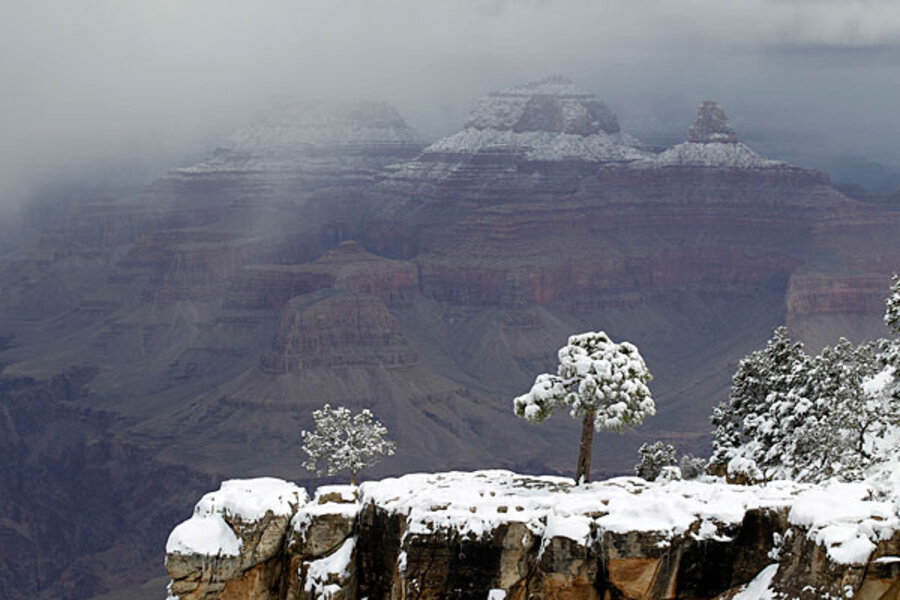'Unearthly' beauty tops jobs? Obama freezes mining near Grand Canyon.
Loading...
Teddy Roosevelt can rest easy. The Obama administration on Wednesday formally unveiled a plan to ban new uranium and other mining claims on 1 million acres of federal lands bordering the Grand Canyon for 20 years – a move that follows in the footsteps of the 26th president's efforts in the early part of last century.
With the price of uranium soaring on international markets, thousands of new mining claims were posted in recent years on lands near the canyon – some within site of public viewing areas. Now, all nascent claims will be blocked from development, although a handful that had already reached a required federal threshold for development may ultimately proceed.
The administration move was telegraphed in June by Secretary of the Interior Ken Salazar, who at that time, announced an "emergency" six-month extension of a ban on mining development in the area. He also endorsed the most restrictive of several options then under consideration to "ensure that all public lands adjacent to the Grand Canyon National Park are protected from new hard-rock mining claims, all of which are in the watershed of the Grand Canyon."
Wednesday's announcement was unveiled in a press release without other fanfare by the Bureau of Land Management (BLM).
“The Grand Canyon is an iconic place for all Americans and visitors from around the world,” said BLM Director Bob Abbey in a statement. “Uranium remains an important part of our nation’s comprehensive energy resources, but it is appropriate to pause, identify what the predicted level of mining and its impacts on the Grand Canyon would be, and decide what level of risk is acceptable to take with this national treasure."
The "preferred alternative," he noted, would allow for "cautious, continued development with strong oversight that could help us fill critical gaps in our knowledge about water quality and environmental impacts of uranium mining in the area.”
There remain 11 uranium mining claims that, before the 2009 federal freeze, had already attained the he status of "valid and existing rights" and which could go forward, the BLM reported.
But several environmental groups would fight the validity of those claims in court, said Roger Clark, a spokesman for the Grand Canyon Trust. There is already one uranium mine – the Arizona 1, owned by a Canadian company – with ongoing operations.
Several moves afoot in Congress aim to unwind the presidential action. A measure appended to a House bill that funds the Department of Interior targets such regulations. And legislation unveiled in the House and Senate last month – backed by Sen. John McCain (R) of Arizona – would nullify the move.
The Wednesday decision does not take effect for another 30 days. Even after that, Congress has 90 days in which it could – through a joint resolution that would not need President Obama's signature – reverse the measure. With Democrats controlling the Senate, this is seen as unlikely.
Moreover, such a move would flout history and an American icon, say environmentalists.
But mining advocates say the White House move to squelch mining could raise the "jobs issue." It takes "$30 billion of American economic wealth and jobs off the table," Bob Weidner, director of government affairs for American Clean Energy Resources Trust, a pro-mining advocacy group, told the Monitor in June.
A BLM analysis suggests that the impact will be far less. Under the new plan, $1.2 billion in regional economic output over 20 years is expected versus $3.4 billion under the scenario in which mining went ahead unfettered.
President Roosevelt, who once described the canyon in personal letters as “beautiful and terrible and unearthly” was the first to use his presidential authority to withdraw the Grand Canyon from mining development – until Congress in 1919 created Grand Canyon National Park.
Now Mr. Obama has taken a major step in the same direction.
"This is a great move by the Obama administration, and we commend them for protecting the Grand Canyon from new uranium mining," says Jane Danowitz, director of the US public land program at the Pew Environment Group in Washington. "Looking down the road, this is something he will be long remembered for – preserving this place so special to the American people from harmful mining."





